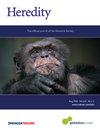利用定量遗传模型的统计估算模拟功能加性和非加性遗传效应。
IF 3.1
2区 生物学
Q2 ECOLOGY
引用次数: 0
摘要
随机模拟软件通常用于帮助育种人员设计具有成本效益的育种计划,以及验证遗传评估中使用的统计模型。软件的一个基本特征是能够模拟具有所需遗传和非遗传参数的种群。然而,由于模拟种群的所需特性是通过在种群水平上制定的经典定量遗传统计模型估算的,因此在模拟显性或外显的非加成效应时,这一功能往往会失效。该软件在个体水平上模拟基因型值的基本功能效应,这些效应不一定与包含显性和外显的统计模型的效应相同。本文为此类模拟中功能效应和统计效应之间的转换提供了理论基础和数学公式。本文通过分析单一种群中个体表型(动物育种中常见)和涉及两个近交种群的三元杂交种的小区表型(某些作物育种项目中常见)的两个统计模型来演示这种转换。我们还介绍了模拟加性遗传、显性遗传和外显遗传的功能效应的不同方法,以便在数量遗传学中使用的经典统计模型中实现所需的方差分量水平。本文章由计算机程序翻译,如有差异,请以英文原文为准。
Simulation of functional additive and non-additive genetic effects using statistical estimates from quantitative genetic models
Stochastic simulation software is commonly used to aid breeders designing cost-effective breeding programs and to validate statistical models used in genetic evaluation. An essential feature of the software is the ability to simulate populations with desired genetic and non-genetic parameters. However, this feature often fails when non-additive effects due to dominance or epistasis are modeled, as the desired properties of simulated populations are estimated from classical quantitative genetic statistical models formulated at the population level. The software simulates underlying functional effects for genotypic values at the individual level, which are not necessarily the same as effects from statistical models in which dominance and epistasis are included. This paper provides the theoretical basis and mathematical formulas for the transformation between functional and statistical effects in such simulations. The transformation is demonstrated with two statistical models analyzing individual phenotypes in a single population (common in animal breeding) and plot phenotypes of three-way hybrids involving two inbred populations (observed in some crop breeding programs). We also describe different methods for the simulation of functional effects for additive genetics, dominance, and epistasis to achieve the desired levels of variance components in classical statistical models used in quantitative genetics.
求助全文
通过发布文献求助,成功后即可免费获取论文全文。
去求助
来源期刊

Heredity
生物-进化生物学
CiteScore
7.50
自引率
2.60%
发文量
84
审稿时长
4-8 weeks
期刊介绍:
Heredity is the official journal of the Genetics Society. It covers a broad range of topics within the field of genetics and therefore papers must address conceptual or applied issues of interest to the journal''s wide readership
 求助内容:
求助内容: 应助结果提醒方式:
应助结果提醒方式:


